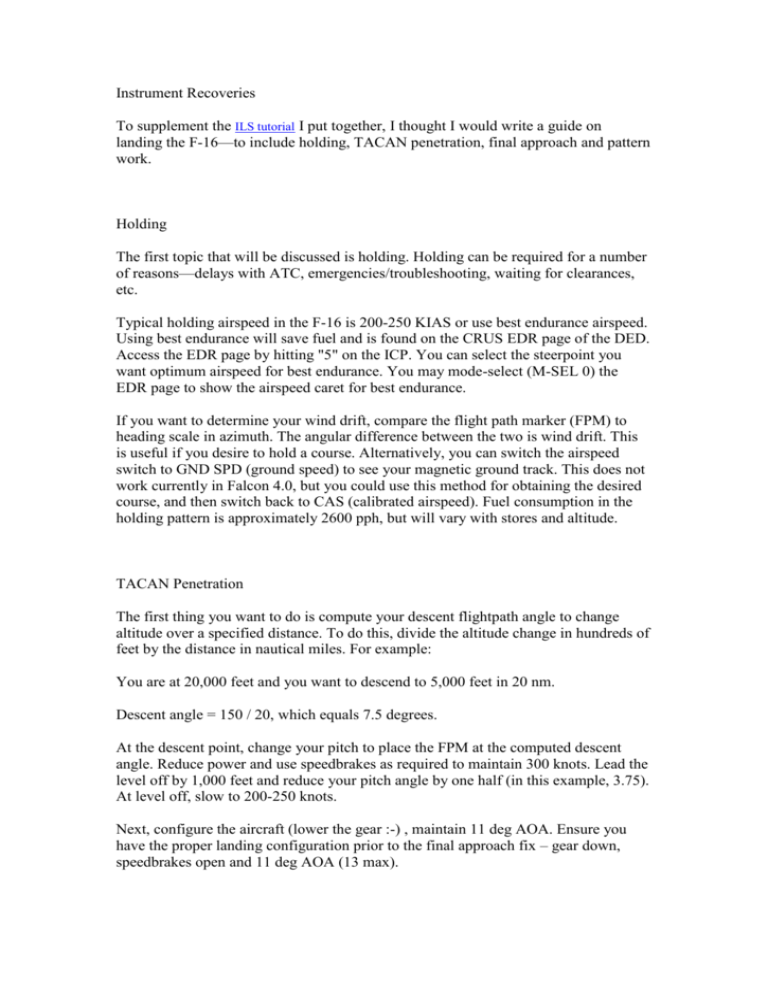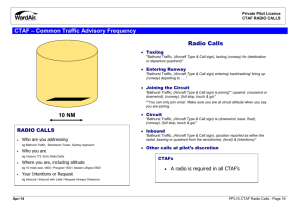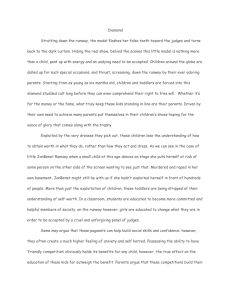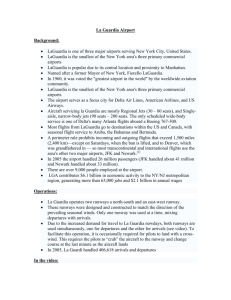Landing Pattern - e-HAF
advertisement

Instrument Recoveries To supplement the ILS tutorial I put together, I thought I would write a guide on landing the F-16—to include holding, TACAN penetration, final approach and pattern work. Holding The first topic that will be discussed is holding. Holding can be required for a number of reasons—delays with ATC, emergencies/troubleshooting, waiting for clearances, etc. Typical holding airspeed in the F-16 is 200-250 KIAS or use best endurance airspeed. Using best endurance will save fuel and is found on the CRUS EDR page of the DED. Access the EDR page by hitting "5" on the ICP. You can select the steerpoint you want optimum airspeed for best endurance. You may mode-select (M-SEL 0) the EDR page to show the airspeed caret for best endurance. If you want to determine your wind drift, compare the flight path marker (FPM) to heading scale in azimuth. The angular difference between the two is wind drift. This is useful if you desire to hold a course. Alternatively, you can switch the airspeed switch to GND SPD (ground speed) to see your magnetic ground track. This does not work currently in Falcon 4.0, but you could use this method for obtaining the desired course, and then switch back to CAS (calibrated airspeed). Fuel consumption in the holding pattern is approximately 2600 pph, but will vary with stores and altitude. TACAN Penetration The first thing you want to do is compute your descent flightpath angle to change altitude over a specified distance. To do this, divide the altitude change in hundreds of feet by the distance in nautical miles. For example: You are at 20,000 feet and you want to descend to 5,000 feet in 20 nm. Descent angle = 150 / 20, which equals 7.5 degrees. At the descent point, change your pitch to place the FPM at the computed descent angle. Reduce power and use speedbrakes as required to maintain 300 knots. Lead the level off by 1,000 feet and reduce your pitch angle by one half (in this example, 3.75). At level off, slow to 200-250 knots. Next, configure the aircraft (lower the gear :-) , maintain 11 deg AOA. Ensure you have the proper landing configuration prior to the final approach fix – gear down, speedbrakes open and 11 deg AOA (13 max). The Pattern FIRST A LITTLE THEORY The overhead is the pattern of choice for all USAF fast movers. It is also the preferred method for ATC controllers. You can get the max number of jets on the ground, the fastest, save the most gas, etc....It is easier for the tower to control and as pilots, it becomes intuitive. My students learn this during the first block of training. I fly this pattern probably 20 times a day, flying three sorties. It is our bread and butter. For the studs it is difficult, but they soon master it. After a while you fly an overhead like you park your car. It is natural. I will describe a generic overhead for all fast movers. Realize there are caveats to it: Emergencies, tactical formations, tactical arrivals among others. INITIAL The overhead begins at initial. How you get to initial varies. It could be VFR (you basically fly yourself there), via radar vectors (typical in USAF peacetime) or some local arrival procedure, also very common. The initial point is typically 4-5 miles from the approach (the end you are flying to) end of the runway. Local conditions may dictate otherwise and every base would modify this somewhat based on several factors: hospitals,schools, population, weapon's storage areas you can't fly over etc.) Arrive on initial at 1500 feet AGL. So if field elevation is 200 feet you would fly 1700 on your altimeter. You will fly 300 knots on runway heading, 1500 agl and fly over the runway. In the US we have a rule that says unless you are in special use airspace (MOA'S, weapons ranges restricted areas) the max speed you can fly under 10,000 feet is 250 indicated. US fighters have a waiver to go 300. DON'T GET A SPEEDING TICKET! Yes it may seem boring to fly 300 knots straight and level for 4-5 miles but we do it. THE BREAK The break is where the fun begins. The break zone is usually around the first 3000 feet of runway length. Kinda hard to tell this in the game, much easier in the jet, so I just use half way down. You can break anywhere in this break zone. I tell my studs to wait to the end, traffic permitting to give them more time to configure. The break is a LEVEL 60 degree, 2-3g turn, rolling out 180 from runway heading. You want to displace yourself about 3/4 of a mile from the runway, no wind. (TECHNIQUE) Flying is more art than science and there are MANY ways to get the jet to go where you want it (I always have to remind my studs to be a pilot, not a passenger!) Some guys may lower the speedbrake in the break, some may wait until you roll out. Some go to idle, some back to 80%. It depends how aggressive you are. If you break "Over the numbers", you are going to have a harder time getting configured so you may want idle/speed brake. INSIDE DOWNWIND This point, after roll out is Inside Downwind. Every jet has a minimum speed for inside downwind. I don't know what the F-16s is so I just use 200. Your goal is to be configured, trimmed up, ready to perch. DON 'T GET SLOW. This is taboo. Be careful not to drift one way or another. Pick a point off the nose and fly to it. Don't forget to get your gear DOWN. (True Fact) The guys in my job who tend to land gear up (happens about once a year) are not students. It is usually a solo IP! CRUNCH. THE PERCH The perch is where the final turn begins. It is a 180 descending turn using around 1500 feet per minute decent. Your goal is to arrive on ½ mile final. A typical perch point is about when the approach end is 45 degrees off your shoulder. I tell my studs to use the rank on their shoulder. I use the aft portion of the missile rail in the game. THE FINAL TURN The final turn is probably the scariest portion of training for us IP's . It us usually between 30-45 degrees of bank. The speed you fly is based on your weight. I just use 175 for the game. Probably a little fast in reality. You are flying to a roll out point ½ mile from the end. I constantly say "airspeed, rollout point and aimpoint" over and over until they get the hang of it. FINAL Whew! The hard part is over, now you just slow to final airspeed (again, based on weight, I start at 155 and and adjust to the green doughnut (AOA indicator). Now just land. Simple, huh? FATAL ERRORS a. Getting too slow on inside downwind. If you perch too slow and don't recognize it, you will be very close to your stall margin. b. Getting to SLOW in the final turn. Pull too much, stall, die. c. Overshooting final and racking the jet up. Stall speed increases greatly as bank increases. Too much bank = less lift = stall and die d. Undershooting final raising the nose to shallow out. Too slow = stall = die. See a trend here? ATC CALLS Usually you will tell ATC you want vectors to initial. They will give them to you and tell you to report initial with tower. After arriving there, and switching there you would usually say "CALL SIGN-Initial" I.e. Claw 1 initial". If you are at an out base or a place that does not have fighters you might add the distance- "Claw 1, 5 mile initial" Unless there is traffic tower will usually say "Claw 1, cleared to break your discretion." The next radio call in fighter lingo is made during the final turn. "Claw 1, base, gear, stop." Meaning Claw 1, base leg (final turn), gear down full stop. If you want a touch and go you just don't say stop. Tower will respond, Claw 1 cleared to land, cleared touch and go, or the most common, cleared the option, which means you can either go around, touch and go, or full stop. FORMATIONS The overhead is designed for multiple jets. You can have as many 4 ships as you want 30 seconds apart. Lead will usually break over the numbers, two will go 5 seconds later, etc. The timing is less important than watching leads rate of pull. If he pulls hard, you need to go sooner. If he pulls a lazy break, you need to ease off. This is important to maintain proper spacing. I tell my studs to go when he is abeam the wing. Again, there are caveats to this, but this is the generic overhead. - Chuck / F4UT Here is another guide. The Overhead Break by Lt. Mouse and Maj. Jester - 87th Stray Dogs This is the pattern used by highly maneuverable aircraft such as fighters. The primary reason this pattern is used is because when fighter aircraft have to land near hostile territory, the last thing they want to do is fly an ILS approach, where they are low and slow for 10-15 miles. This would make it too easy for someone on the ground to fire at it. In peacetime, the pattern is also good because it is more efficient (can handle a lot of aircraft) and faster (aircraft can conduct more approaches in a shorter amount of time) than the standard rectangular pattern. The overhead pattern is called such because aircraft enter the pattern by flying overhead the runway. This is called "initial". The aircraft at initial fly directly over the runway (in the same direction of the runway in use) at approximately 1,500 feet above ground level (AGL). In real life the tower controller would give them pattern altitude and the direction of their turn, if they are not familiar with the airport. When the aircraft reaches the approach end of the runway, it can make a steep turn to enter "inside downwind". This turn is referred to as "break" turn, and is usually made before the aircraft gets half way down the runway. However, the controller can tell the pilot where to "break" if it helps with sequencing and traffic flow (see examples below). The aircraft then enters "inside downwind", which is a parallel path approx 1/4 - 1/2 mile from the runway. The aircraft is still at 1,500 feet AGL and is slowing down in preparation for landing. When he passes a point that is past the approach end of the runway, the pilot will turn "base". This is similar to a rectangular pattern "base", but its more aggressive and the aircraft is losing a lot more altitude over a short distance. The pilot will then line up approx 1/2 mile from the runway on "short final" and prepare to land, do a touch-and-go, etc. Standard Overhead pattern and landing: A) Flight passes initial (point 3 miles extended runway centerline) at 1500` with flight-members in "echelon" (= all to one side; in this case the right side). Std speed = 300 kts (but might vary). B) Lead breaks "over the numbers"(= over the beginning of the runway) then performs a right turn at 60 degrees angle of bank to downwind while retarding the throttle to IDLE, this should slow the aircraft down to about 230-250 knots on downwind. B2) Wingmen take 3-4 seconds spacing each then perform exactly as lead does (count slowly!, REAL seconds). Each flight member slows to final-turn speed (+/- 20 kts above final aproach speed, should be roughly 180 knots). C) Approaching "the perch" (= turning poin to final; defined by an immaginairy line 45 degrees behind to the beginning of the runway) each flight member lowers the landing gear and extends speedbrakes. Start the final turn at the "perch" (ALL must use the same turning point, not to mess up the spacing!). Plan the angle of bank (AOB) so that you reach final at a point opposite the "perch". D) Make the landing on the upwind-side, called "hot lane" (= "the side where the crosswind blows from"; this will be called out by the leader: "left lane, hot lane"). It is important NOT to brake to hard, to avoid pile-up on the runway. In fact, the lead would not use his brakes at all; 2 a bit, 3 a bit more, ect. E) When speed is "under control" (close to taxi speed) switch to the "cold lane" (you guessed it: in this case the right lane) IF your spacing for landing is NOT enough, go around ("3, short final going around") and pull up at the departure end for another overhead pattern. "The reason for the "hot-lane procedure" is to cater for abnormal situations as brake failure, blown tire s, etc. The effected fighter is always able to overtake the guy in front without the danger of a collission.I guess you could look at it this way: the hot lane is our runway and the cold lane the taxiway. Downwind Short Final Final Approach This portion will provide information on both precision and non-precision final approach procedures. For nonprecision approaches, establish 1,000 – 1,500 ft/min descent rate, which is approximately 4 deg down with the FPM in the HUD. Maintain 11 deg AOA (13 max) and descend to the minimum descent altitude. During mission planning, you can calculate the nonprecision approach pitch angle using the same formula used above. Example: Descend 1,000 feet in 3.5 nm yields a 2.85 required pitch change. As a rule of thumb, use a 1 deg descent angle to descend 100 ft/min and a 4 deg descent angle (4 degs for 1 nm = 400 feet) works well for nonprecision approaches. For the downwind leg, fly 200-250 knots. As you turn to the base leg, slow to 200 knots, configure the jet (as above) and establish 11 deg AOA (13 max). On final approach, recheck that the jet is configured to land once more. Fuel required for the approach should be around 400 lbs. Which approach method is best? An 11 deg AOA approach is preferred over a 13 degree. It allows better pitch control, better over the nose visibility, and a more stable HUD presentation. The aircraft wallows less in gusty winds and sink rate is easier to control during the flare. The aircraft floats 800 – 1,200 feet from flare to touchdown. The 13 deg AOA approach has its good features also. This approach allows better control of the touchdown point and more efficient energy dissipation. The flare, however, is more difficult because the AOA is already 13 deg, and care must be exercised to avoid scraping the speedbrakes or a hard landing. The aircraft floats approximately 500 to 700 feet from flare to touchdown. Small throttle adjustments will be needed for both. Avoid premature or large thrust reductions on short final which may cause increased sink rates and a hard landing. Likewise, avoid large or rapid roll inputs as the FLCS uses the flaperons to produce the roll, thus also producing a loss of lift. Use thrust rather than aft stick to control undesirable sink rates. Increased aft stick, especially if established at 13 deg AOA, may result in a tail strike. Crosswind landings are made using a crab technique. For an ILS approach, maintain 11 deg AOA with the FPM on the –2.5 deg pitch line and descend to decision height. See the ILS tutorial for ILS procedures. If a go-around or missed approach is needed, advanced power as required, retract the speedbrakes, establish a positive rate of climb, retract the gear and accelerate to 250 knots. Don’t forget to crosscheck your basic instruments with the HUD and execute climbout instructions as required. This ends the tutorial. Happy landings. -mirv





